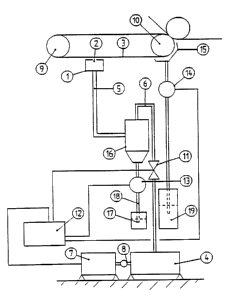Une partie des informations de ce site Web a été fournie par des sources externes. Le gouvernement du Canada n'assume aucune responsabilité concernant la précision, l'actualité ou la fiabilité des informations fournies par les sources externes. Les utilisateurs qui désirent employer cette information devraient consulter directement la source des informations. Le contenu fourni par les sources externes n'est pas assujetti aux exigences sur les langues officielles, la protection des renseignements personnels et l'accessibilité.
L'apparition de différences dans le texte et l'image des Revendications et de l'Abrégé dépend du moment auquel le document est publié. Les textes des Revendications et de l'Abrégé sont affichés :
| (12) Brevet: | (11) CA 2201513 |
|---|---|
| (54) Titre français: | PROCEDE ET APPAREIL D'EVACUATION DE L'EAU DE LA SECTION TOILE ET/OU PRESSE D'UNE MACHINE A PAPIER OU ANALOGUE |
| (54) Titre anglais: | PROCEDURE AND APPARATUS FOR THE DRAINAGE OF THE WIRE AND/OR PRESS SECTION OF A PAPER MACHINE OR EQUIVALENT |
| Statut: | Périmé |
| (51) Classification internationale des brevets (CIB): |
|
|---|---|
| (72) Inventeurs : |
|
| (73) Titulaires : |
|
| (71) Demandeurs : |
|
| (74) Agent: | GOWLING LAFLEUR HENDERSON LLP |
| (74) Co-agent: | |
| (45) Délivré: | 2007-01-30 |
| (86) Date de dépôt PCT: | 1995-09-22 |
| (87) Mise à la disponibilité du public: | 1996-04-25 |
| Requête d'examen: | 2001-12-14 |
| Licence disponible: | S.O. |
| (25) Langue des documents déposés: | Anglais |
| Traité de coopération en matière de brevets (PCT): | Oui |
|---|---|
| (86) Numéro de la demande PCT: | PCT/FI1995/000521 |
| (87) Numéro de publication internationale PCT: | WO1996/012064 |
| (85) Entrée nationale: | 1997-04-01 |
| (30) Données de priorité de la demande: | ||||||
|---|---|---|---|---|---|---|
|
Procédé d'évacuation de l'eau de la section toile et/ou presse d'une machine à papier, selon lequel au moins un tuyau d'aspiration (1) est pourvu d'au moins un orifice (2), et raccordé à un dispositif à vide (4) servant à faire le vide au moins dans ce tuyau d'aspiration. En outre, selon le procédé, on fait passer sur l'orifice du tuyau d'aspiration un feutre, une toile ou analogue, l'eau étant de ce fait évacuée du feutre, de la toile ou analogue. Selon ledit procédé, on règle le degré de dépression en mesurant et/ou en réglant au moins la quantité d'eau évacuée par le tuyau d'aspiration (1) et, en fonction des données mesurées, on règle le degré de dépression à l'aide de dispositifs de régulation (11, 12). On a également prévu un appareil de réglage du degré de dépression.
Paper drainage and drying is required in modern high
speed paper machines where the number of suction boxes is
limited. The present method provides a procedure for the
drainage of the wire and/or press section of a paper
machine, in which procedure at least one gap and the
suction pipe is connected to a vacuum device to develop a
vacuum at least in this vacuum pipe, and in which
procedure a felt, wire or equivalent is moved over the
gap of the suction pipe, water being thus drained from
the felt, wire or equivalent. In the procedure, the
vacuum capacity is adjusted by measuring and/or adjusting
at least the amount of water drained from the suction
pipe and, on the basis of the measured data, adjusting
the vacuum capacity by means of regulating devices. The
invention also relates to an apparatus for adjusting the
vacuum capacity.
Note : Les revendications sont présentées dans la langue officielle dans laquelle elles ont été soumises.
Note : Les descriptions sont présentées dans la langue officielle dans laquelle elles ont été soumises.

Pour une meilleure compréhension de l'état de la demande ou brevet qui figure sur cette page, la rubrique Mise en garde , et les descriptions de Brevet , États administratifs , Taxes périodiques et Historique des paiements devraient être consultées.
| Titre | Date |
|---|---|
| Date de délivrance prévu | 2007-01-30 |
| (86) Date de dépôt PCT | 1995-09-22 |
| (87) Date de publication PCT | 1996-04-25 |
| (85) Entrée nationale | 1997-04-01 |
| Requête d'examen | 2001-12-14 |
| (45) Délivré | 2007-01-30 |
| Expiré | 2015-09-22 |
Il n'y a pas d'historique d'abandonnement
Les titulaires actuels et antérieures au dossier sont affichés en ordre alphabétique.
| Titulaires actuels au dossier |
|---|
| ECOPUMP OY |
| Titulaires antérieures au dossier |
|---|
| KARVINEN, JUHA |